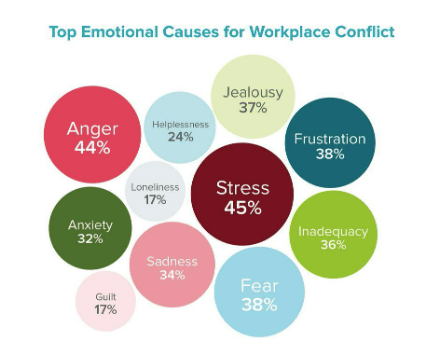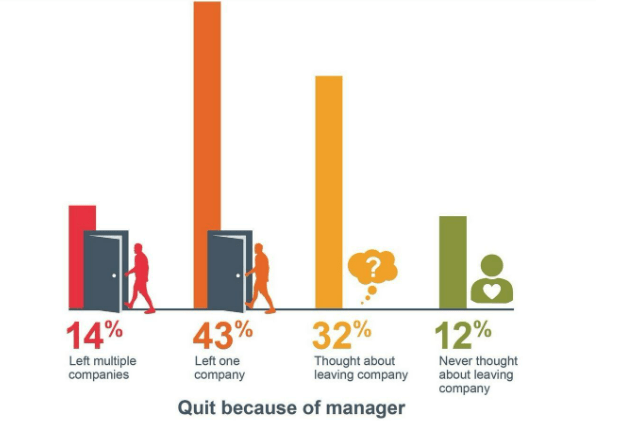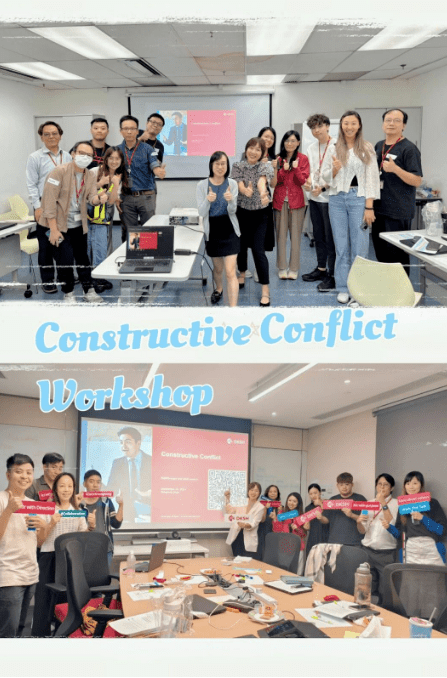“My colleague is driving me crazy. She inexperienced but thinks she knows everything about everything.”
“I enjoy the work, but I can’t stand my coworker.”
What if your employees, just like in those real-life cases, also agree only on one thing—that the other is the problem in the workplace? Disagreements can also arise between several team members or even departments in your company.
You can’t simply watch that friendly fire spreading all over your workplace. Neither can you put your headphones on and pretend you don’t hear that dissonance in internal communications or see those angry looks your employees cast at each other.
Let’s see how such disharmony impacts the team’s dynamics and employee well-being overall and where it may eventually lead your company. After that, we’ve compiled the most appropriate team-building strategies and activities for coworkers who aren’t getting along.
Table of Contents
- What May Happen to the Team When Employees Are at Odds
- 6 Strategies for Successful Team Building When Employees Don’t Get Along
- Help Employees Get Along and Build a Harmonious Team with Outback
- Author Bio
What May Happen to the Team When Employees Are at Odds
More Workplace Conflicts
When employees don’t get along, the first thing that happens to the team is the swelling up amount of interpersonal or team-against-team clashes at work.
Depending on the work mode, there may be in-office or virtual workplace conflicts like these:
- Conflict of personal interests
- Work-style conflict
- Task/project conflict
- Leadership conflict
- Conflict of generations (particularly in multi-generational teams with a wide age gap)
- Discrimination or harassment
For example:
Let’s take those classic “air-conditioning wars” in offices. Then, there are typical “talking-over-each-other” scenarios during remote meetings over the web.
Toxic Atmosphere and Its Impact on Employees’ Health
Much like diseases, constant employee disagreements and conflicts catch on and infect the whole group. Studies prove that negative feelings like anger have considerably higher emotional contagion or “virality” than positive ones.
As a result, you’ll have to deal with toxicity and negativity at work, which make employees feel unwell and experience physical, mental, and social discomfort. When it comes to emotional well-being specifically, 63% of workers blame a toxic corporate atmosphere for their negative mental health.

Low Productivity
What if we told you that every employee loses roughly three hours weekly while quarreling with colleagues?
That’s what CPP Global revealed in their research. Yet, it’s not only about losing time. When colleagues aren’t getting along, the aftermath is also about poor productivity provoked by these factors (cited by workers in the same report):
- Demotivation (21%)
- Frustration (18%)
- Sleeplessness and stress (9%)
What’s worse—teams with conflicting employees are disharmonious and unproductive. Teamwork looks more like a tug-of-war rather than a smooth collaboration.
High Turnover and Project Failures
“I quit my job […] because I couldn’t handle the hostile environment, and I was stressed out.”
Or—
“I don’t get along with my manager to the point where I seriously consider resigning during the probation period.”
Again, these situations happened in real life to employees who couldn’t stand the toxic work culture or conflicted with their boss. Mind: People quit their managers, not companies; at least 57% do.

Now, consider this: nearly every fourth worker (23%) leaves the company, and every fifth (18%) witnesses project collapses because of workplace disagreements. As you can understand, high employee turnover or even business fiascos aren’t uncommon in conflicting teams.
Legal, Reputational, and Financial Troubles
David Haskins, CEO at WrongfulDeathLawyer.com, remarks that workplace conflicts may also trigger gruesome consequences for employers in terms of law, PR, and finances.
“Verbal abuse is a cause of action for employees to file a hostile work environment lawsuit. The latter typically costs companies thousands to millions of dollars, let alone the damage to their reputation.
And once personal clashes grow into physical violence at work, they end in injuries, absenteeism, and workers’ compensation claims.”
Even an innocent (at first glance) CAPS LOCK message may snowball into: “Let’s take it outside,” going from words to wounds, literally.
6 Strategies for Successful Team Building When Employees Don’t Get Along
Resolve conflicts first (and teach how to handle them in the future).
Let’s admit it—you can’t move even a single inch forward in building a happy team if you don’t resolve workplace conflicts at their starting phase. As they say, it’s always better to trim the trouble before it doubles.
Besides, it’s also advisable to organize conflict resolution workshops as team-building activities for employees to help them develop skills like:
- Active listening
- Emotional intelligence
- Cultural sensitivity
- Empathetic communication
- Negotiation
- Non-violent behavior
For example:
Take a glimpse of this Constructive Conflict Workshop at DKSH led by the company’s Assistant Manager.

But you don’t necessarily have to run it alone. You can always ask knowledgeable experts and coaches to arrange it for you. For instance, Outback offers a Conflict Resolution Program with engaging group exercises guided by an on-site event facilitator.

Encourage open conversations and organize talk-it-out sessions.
“Workplace tension between employees might be simmering under the surface. It doesn’t even have to be verbalized; it’s visible to the naked eye via non-verbal cues,” notes Laurence Bonicalzi Bridier, CEO at ArtMajeur by YourArt.
Actually, this is often referred to as passive-aggressive behavior at work when colleagues show hostility to each other, not verbally. It manifests through their body language: crossed arms or legs, sarcastic smiles, dramatic eye rolls, impatient finger-tapping, etc. On the contrary, they can avoid eye contact or communication altogether.
That’s why when asked about the best team-building ideas for employees who don’t get along, Laurence Bonicalzi Bridier recommended, “Your workers must bring it to the surface and verbalize it. In this case, employee feedback circles and talking-it-out hours have an immense therapeutic effect.”
For example:
Look at this Dialogue Circle, a team-building activity at KAICIID.

If you manage a remote workforce, you can talk it all out during virtual team building activities, such as online coffee breaks or feedback sessions via Zoom.
Laugh all the tension away.
Did you know humor is a natural pill against psychological pressure and physical tension?
If you’re not convinced, the following fact will certainly persuade you to use humor for team building when workers aren’t getting along. A cheerful work environment can decrease employee stress by up to 30% and create a more positive corporate atmosphere.
So, why not let humor smooth out sharp edges between your team members?
Here’s a list of fun and merry team-building activities for your consideration:
- Improv Shows or Comedy Stand-Ups
- Wacky Would-You-Rather Questions
- Meme-Creation Contests
- White Elephant Gift Exchanges
- Lip-Sync Battles
- Wild Goose Chases or Scavenger Hunts
For example:
The PlentyOfFish team went on The Amazing Chase (for four years in a row!) with Outback. Why? Because it’s a series of super-fun, mood-boosting challenges around the city.

Or—
Heed this call from Morgan Taylor, Co-Founder of Jolly SEO, whose distributed team cracks the laughter code (and SEO code, too!) via Slack. “Set up a virtual water-cooler chat for your team members to laugh the tension off and connect emotionally through humor. You can meet at an informal digital spot and exchange smiles, even if they’re just emojis.”
For example:
Jolly SEO’s “water-cooler” on Slack is full of hilarious memes and pictures of workers’ pets in the most amusing poses.

Unite them around your corporate value(s).
If laughter is practically a panacea against workplace stress and nervousness, then corporate values are the most powerful team anchors. They tie up your team members and dock them to one harbor.
Constantly remind your employees that you’re in the same boat with a collective mission statement and core values. These can be:
- Integrity and ethics
- Customer-centricity
- Transparency
- Work-life balance
- Innovation
- Corporate social responsibility (CSR)
Suppose CSR is one of the key values in your company. Then, it would be better to prioritize sustainable or charitable team building ideas. If your workers are at odds, they will team up to reach a mutual goal, eco-friendly or philanthropic.
For example:
At this point, Pfizer can teach us an invaluable lesson on uniting employees around a shared purpose. The team regularly volunteers and launches charity initiatives, such as a Charity Bike Buildathon arranged by Outback or Give a Hand Day.

They always do that in custom T-shirts, hoodies, or aprons branded with Pfizer’s logo and color to enhance a sense of belonging and togetherness.
Celebrate rather than oppose differences.
What if your team members can’t get along due to misunderstanding workplace diversity? They may regard individual peculiarities as something antagonistic or even malicious.
As Conrad Wang, Managing Director at EnableU, points out, “Your differences—gender, geographic, cultural, or psychological—don’t make you misfits. They make you richer and stronger as a team. Prove your employees that their diverse backgrounds complement rather than contradict each other and let them appreciate everyone as a unique human being first (and coworker second) through diversity celebrations.”
You can celebrate diverse holidays like Pride Month in June. For example, consider the Pride Edition of Jeoparty Social at Outback and dive deeper into the LGBTQIA+ culture.

Note: When it comes to LGBTQIA+ employees, the statistics are quite discouraging. They are more likely to face harassment and humiliation at work: 55% of transgender employees experienced those at work, compared to 29% of heterosexuals.
Give them a common problem.
When conflicting employees face one challenging situation for both, they automatically become allies who join forces to confront one “enemy” for both: a tricky puzzle or a tight deadline.
In the words of Gary Hemming, Owner & Finance Director at ABC Finance, a common struggle creates an “us vs. problems” mentality. “A common challenge switches the employee’s mindset from a disagreement to collaboration on fixing the issue. Moreover, when it is industry-relevant, it’s also a splendid chance to reveal their hidden superpowers—specific job skills—that demonstrate their coworkers’ brilliance in something.”
For instance, a team-building activity for financial specialists can be a “Budgeting Challenge” or “Recover-from-Bankruptcy Mission.”
Then, there are universal problem-solving team building ideas like these:
- Code-Breakers
- Corporate Escape Rooms
- Outdoor Survival Missions
- Marshmallow Tower Challenges
- Mystery-Solving Activities (CI: The Crime Investigators or Clue Murder Mystery)
By the way, those can also be self-hosted and virtual at Outback Team Building! Take the Self-Hosted Hollywood Murder Mystery or Virtual Clue Murder Mystery.

It’s high time to gather your in-person or remote Mission: Impossible squad and embark on problem-solving missions with Outback.
Help Employees Get Along and Build a Harmonious Team with Outback
From conflict resolution training to collaborative problem-solving challenges, Outback can help you prevent workplace dramas and turn conflicting employees into lifetime besties.
Request a quote and build a dream team with no tension or aggression nearby.
Author Bio
Catherine Schwartz is an author who specializes in employee well-being and engagement.



